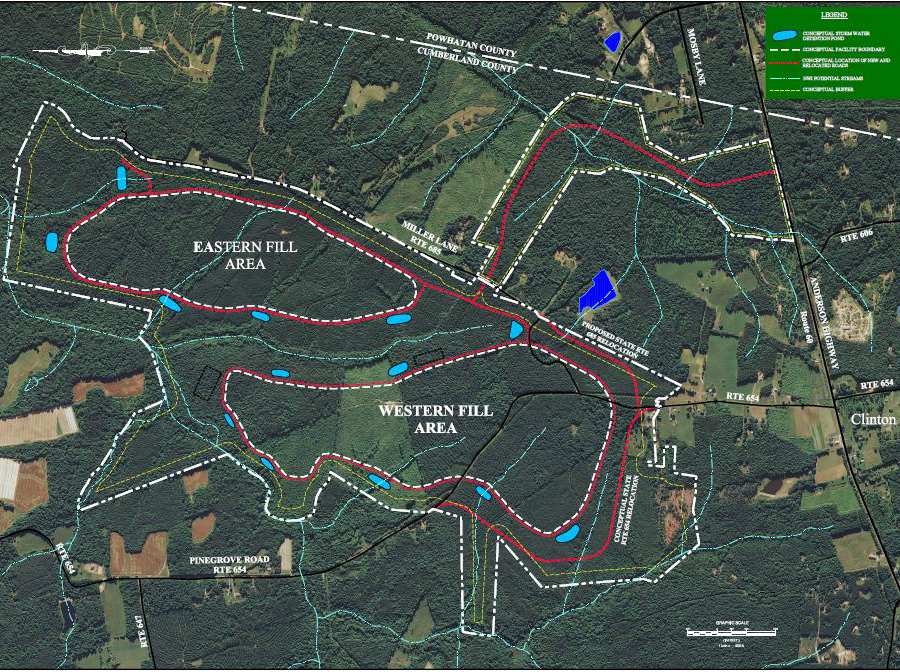
the area of Cumberland County proposed for the Green Ridge Recycling and Disposal Facility and its access road was primarily forest
Source: Green Ridge Recycling and Disposal Facility, Community Meeting Presentation

the area of Cumberland County proposed for the Green Ridge Recycling and Disposal Facility and its access road was primarily forest
Source: Green Ridge Recycling and Disposal Facility, Community Meeting Presentation
A mega-landfill has been proposed several times for Cumberland County. In 2006, the Cumberland Board of Supervisors approved a proposal by Allied Waste (later Republic Services) for a new landfill handling 5,000-7,000 tons per day. The company did not proceed to construction before a major economic recession began in 2007. Republic Services cancelled its development plans and surrendered its permit from the Virginia Department of Environmental Quality (DEQ).
In 2018, the Cumberland County supervisors approved a separate landfill, the Green Ridge Recycling and Disposal Facility. County Waste of Virginia planned to build a mega-landfill that would accept municipal solid waste, construction and demolition debris (CDD) waste, and disaster waste on a site near the border with Powhatan County. Hazardous waste and sludge would not be accepted. Sheetrock was also banned, since the sulfur in decomposing gypsum can create unacceptable odors.
Trash would be accepted from within 500 miles, including from sites outside of Virginia. The company emphasized that it expected to use the landfill primarily for trash that it already collected in Virginia from its existing 300,000 customers, but wanted the flexibility to import trash from other sources "should the market shift dramatically in the future - like it did in 2008 when the bottom fell out."
The company proposed to excavate about 30 feet deep, install liners that would seal off the cells filled with waste, and deposit enough material over 35 years to build mounds 250' high. According to the proposal, groundwater in the area moved about 10 feet per year. If the double liner in a cell leaked, it would take a century for contaminated groundwater to affect the nearest well used for drinking water.1
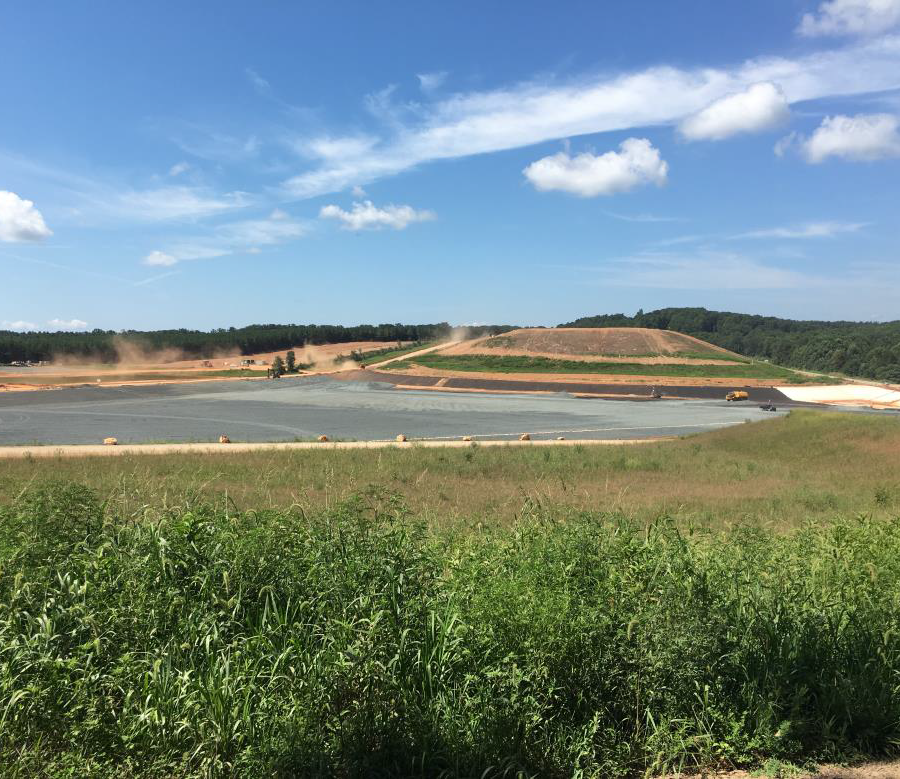
after 35 years, the top of the landfill will be 250 feet higher than the surrounding land
Source: Green Ridge Recycling and Disposal Facility, Community Meeting Presentation
As proposed, the landfill would operate 24 hours-day on Tuesday-Friday, with shorter hours on Saturday and Monday, to receive 3,500-5,000 tons per day of municipal solid waste. No trash would be accepted on Sunday.
The new landfill would allow County Waste of Virginia to become more vertically integrated. After developing the Green Ridge facility in Cumberland County, the company could stop paying competitor Waste Management to use that company's mega-landfill in adjacent Amelia County.
Residents of both Powhatan County and Cumberland County objected to rezoning parcels totaling 1,143 acres to Industrial (M-2) and granting a conditional use permit (CUP) for the Green Ridge Recycling and Disposal Facility. They expressed concerns regarding smell, traffic, noise, and land values. Opponents highlighted that the Amelia County landfill had space remaining for up to 150 more years of trash disposal.
Though 80% of the 250 trucks/day trucks carrying municipal solid waste would use Route 60 in Powhatan County, local officials in Powhatan County had no authority over the proposed facility. Cumberland County officials were responsible for rezoning the location to authorize a landfill, the Virginia Department of Environmental Quality (DEQ) had authority to approve the landfill if it complied with state regulations, and the Virginia Department of Transportation (VDOT) was responsible for managing the additional traffic on Route 60.
The five members of the Cumberland County Board of Supervisors recognized that the landfill would increase county revenues substantially. The county lacked a skilled workforce and was located far from an interstate highway, so it had little potential for attracting job-creating businesses which would generate higher property taxes. Farming and forestry had been the primary land uses in Cumberland County for the last 250 years, and those activities generated only low property taxes.
The process used by the elected officials to approve the project generated a backlash. There were only 35 days from public release of the proposal to final approval. County officials said later:2
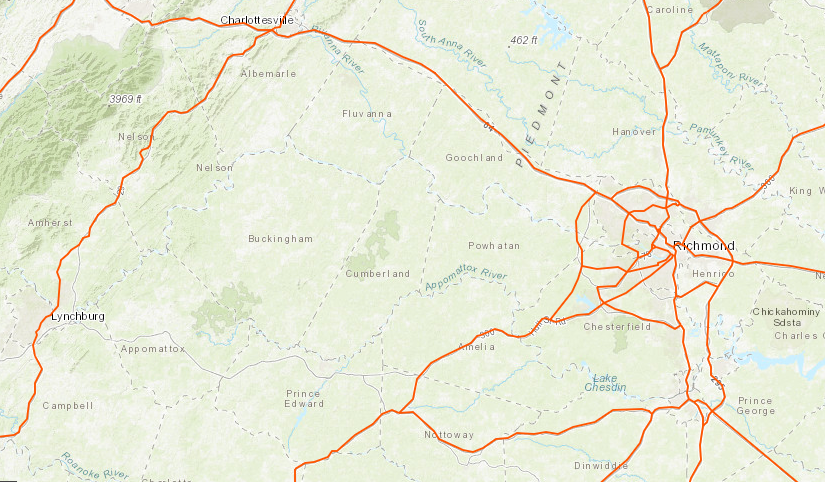
Cumberland County's distance from interstate highways and markets limited the ability to attract new businesses
Source: ESRI, ArcGIS Online
County Waste of Virginia advertised it would create 30 local jobs, and:3
The landfill developer also stated:4
To minimize local opposition, County Waste of Virginia announced it was willing to purchase at full fair market value any property adjacent to the landfill site or access road, and would consider buying other parcels where property owners feared the landfill would impact land values.
The Cumberland County Board of Supervisors approved the proposed landfill in 2018 by a 3-2 vote. The chair of the board commented:5
Gravesites that may be associated with former enslaved workers on a pre-Civil War Cumberland County plantation were identified on the landfill property. Those graves were located in an area that would not be disturbed by construction of the cells, and the landfill developer committed to preserve them.
The proposed location of the landfill was next to Pine Grove School, built in 1916-1917 as one of six Rosenwald Schools built in Cumberland County to educate "colored" students between 1917-1964. The integrity of the building is unusually high; three of the four extant chalkboards are original.
Children in grades 1-6 were taught in that two-room schoolhouse, divided by folding doors. The slate roof was probably sourced from the nearby quarries in Buckingham County. A hipped roof was built rather than a gable roof, which ended up as the model design later in the Rosenwald Fund's Community School Plans published in 1920. The National Trust for Historic Preservation listed Pine Grove School as one of "America's 11 Most Endangered Historic Places for 2021."
Opponents of the landfill proposal raised concerns about environmental justice, suggesting that placing the landfill near minority-race residents was an unfair burden on their community.
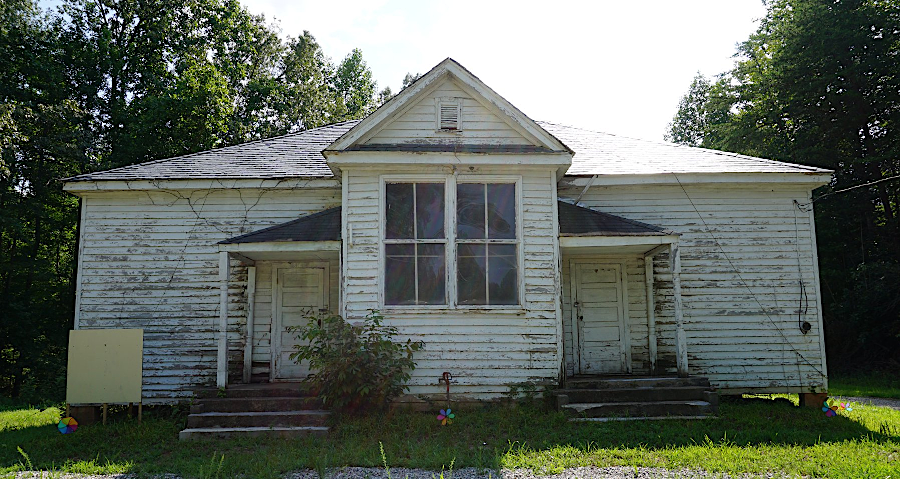
grades 1-6 were taught in the two-room Pine Grove School during Virginia's era of school segregation
Source: Virginia Department of Historic Resources, 024-5082 Pine Grove Elementary School
County Waste of Virginia responded with an economic analysis showing that minorities and low-income communities were not disproportionately impacted:6
At the end of 2019, the Green Ridge Recycling and Disposal Facility project was scaled back. County Waste of Virginia notified county supervisors that the eastern cell would not be developed.
Political opposition to the mega-landfill had affected local and General Assembly elections in 2019. The incumbent Cumberland County supervisor for District 2 was defeated, in large part because he was not seen as effective in fighting the landfill proposed for his district. In addition, the status of the business proposing the landfill changed. GFL Environmental Inc., a Canadian waste management company, acquired County Waste of Virginia.
The original landfill proposal was to construct two cells on 500-650 acres, using half of the 1,200-acre site, to store 69,000,000 cubic yards of waste. The new proposal reduced the footprint of land to be disturbed to 240 acres. The smaller scope eliminated impacts to all primary wetlands, and nearly 40% of the number of houses that would be affected. Total waste to be stored and total revenue for the project would not change, because compacted synthetic foam would be used to cover waste each day rather than dirt.7

in its rezoning application, County Waste of Virginia claimed it had selected to most suitable site in Cumberland County for a landfill
Source: Cumberland County, Application for Change in Zoning
A majority of Cumberland County supervisors remained supportive of the landfill. They anticipated the facility would generate $1.4 million to $2.8 million per year in county benefits for 25-30 years. The facility would increase county revenue from property taxes by 20%. In the absence of industry or other sources of tax revenue, the Cumberland County officials were willing to accept the impacts, including 175-250 truckloads of waste on US 60 for six days/week.
The AMMD Family Association acquired title to Pine Grove School in 2019 and paid back taxes, to avoid having the property be sold at auction. It also organized a non-profit foundation that could accept grants for maintaining interpreting the site. Preservation Virginia included the Pine Grove School Community on its 2020 list of most endangered places in Virginia, and the building was added to the Virginia Landmarks Register and the National Register of Historic Places.
Also in 2020, the AMMD Family Association declined an offer of a percentage of annual fees that landfill users would pay, perhaps as much as $100,000/year, in exchange for supporting the project. The AMMD Family Association rejected the idea that the landfill and the historic setting could co-exist. A leader described the offer as an effort to "buy out" the character of a community of color, and commented:8
A video about the Pine Grove School emphasized that the local community had invested heavily to create the school at a time of Jim Crow segregation that limited public funding for members of that community, and severely constrained their social and economic opportunities:9
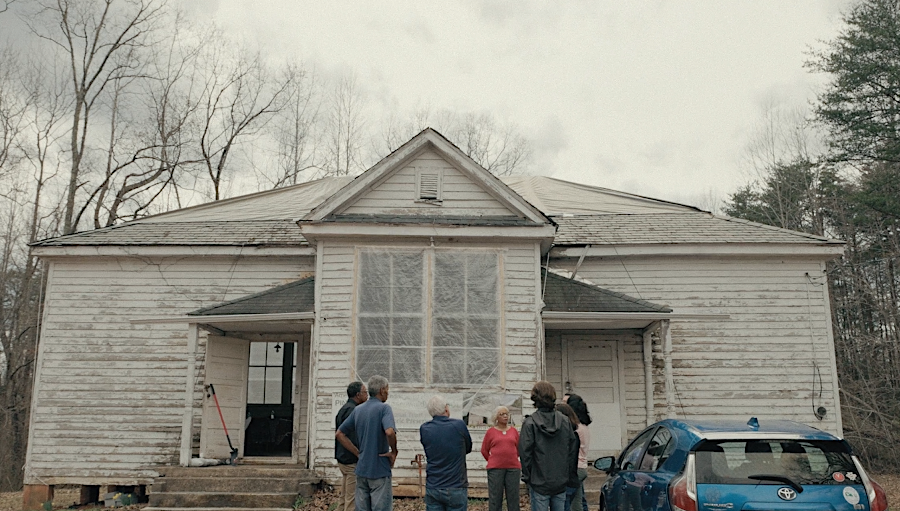
Pine Grove School, built in 1917, in one of the remaining Rosenwald Schools that were constructed between 1917 and 1932
Source: Departure Point Films, LLC, Pine Grove: More Than a School
The trucks filled with municipal solid waste would pass through Powhatan County on US 60, and Powhatan County would receive no revenue from the landfill in Cumberland County. The two counties did not belong to a regional authority for managing waste and sharing revenues. Powhatan would get impacts without benefits.
In the 2021 regular session of the General Assembly, the State Senator for District 10 proposed legislation that would block development of the mega-landfill in District 22. Powhatan County was in District 10, Cumberland County was in District 22. The General Assembly rejected the proposal, as it had done in 2019. Cumberland County officials opposed the ban, noting their need for the tax revenues which the landfill would provide.
An article in the Richmond Times-Dispatch summarized Cumberland County's arguments:10
The National Park Service granted $290,000 to the AMMD Family Association, part of a nationwide effort to preserve sites with significance for civil rights history. Across Virginia, Preservation Virginia determined that more than 380 Rosenwald-funded schools and auxiliary buildings constructed between 1917-1932, and noted:11
By 2024, Cumberland County officials were considering a smaller version of the landfill project. Developers reduced its scope, and requested a conditional use permit to accept only trash generated in Virginia. Plans to reroute Pinegrove Road were eliminated; it would remain a barrier separating the historic 1917 Rosenwald school from the landfill. Height of the planned Green Ridge Recycling and Disposal Facility dropped from 330 feet to 100 feet. Reducing the daily deposition of municipal sold waste from 5,000 tons per day to 1,500 tons per day would require only 75 truck trips per day.
However, those constraints were part of an "initial" proposal. The developers retained the option to request permits later for an expansion of the landfill.12
On April 21, 2025, the Cumberland County Planning Commission recommended denial of the proposed expansion. There were 39 conditions identified in the conditional use permit requested by GFL Environmental for a 104-acre expansion to receive 1,500 tons per day, with all waste to come from within Virginia. Future capacity would be constrained to a 340-acre expansion accepting 3,500 tons per day.
The Planning Commission had recommended denial in 2018 of the first conditional use permit, but the county's Board of Supervisors used their own judgement and approved it.13
The host agreement signed by the Board of Supervisors in 2018 with the landfill developer included a "frustration clause" that limited the capacity of the elected officials to object to the project receiving state and Federal permits. After approving the landfill at the local level, the clause blocked county officials from trying to kill it at the state/Federal level. The clause said::14
When one supervisor talked with constituents about their concerns, he received a cease and desist letter saying that the clause prevented him even from expressing his objections to the proposal with local residents. A lawyer wrote to the county:15
The landfill developer also enlisted local property owners into a Property Values Assurance Program. Those who joined were assured that the company would enhance the price of the property in future sales, but in exchange the property owners could not express objections to the project.16
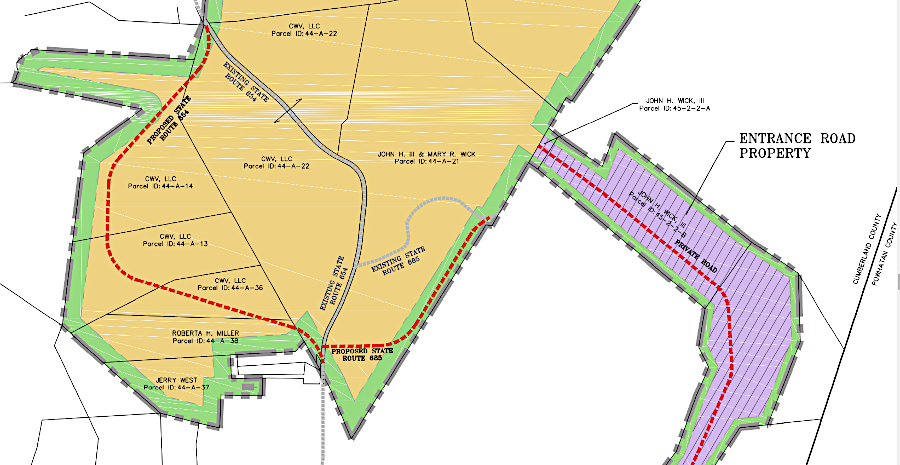
first proposal for the Green Ridge Recycling and Disposal Facility required relocating portions of two state highways
Source: Green Ridge Recycling and Disposal Facility, Part A Permit Application - Attachment PTA-XV
The Cumberland County Board of Supervisors approved a Special Use Permit and revised host agreement on July 28, 2025 by 4-1 votes. That concluded negotiations to revise the initial Special Use Permit, which had been approved in 2018 and had expired the previous month.
In addition to 75-175 trucks bringing 20 tons of waste each per day to the landfill, another 72-303 vehicles per day could bring solid waste to the convenience center there. An initial limit was established of an average of 3,500 tons per day of solid waste, but that cap could be increased later by the supervisors. All waste had to come from within Virginia, and no sludge would be allowed.
The 2018 permit had authorized 5,000 tons of solid waste per day. The old permit had also authorized disposal of waste from places within 500 miles of the landfill - which would have included waste from Georgia, Illinois, and Massachusetts. The new 2025 permit did not include any relocation of Pine Grove Road.
Once Cumberland County approved a final conditional use permit, the developers of the Green Ridge landfill (GFL Environmental) agreed to pay a $200,000 one-time fee. Once the state approved all permits, the county was guaranteed a $1 million fee if the company dropped the project or failed to start operations within three years. Once the landfill was receiving waste, Cumberland County would receive a percentage of the revenue generated, with a minimum of at least $450,000 per year. Total economic benefits to Cumberland County were projected to be $1.7 million annually, including the elimination of current waste disposal costs of $1 million/year.
The initial landfill will occupy 104 acres of the 1,200 acre site. Over the life of the landfill, the landfill will expand to 170 acres. Permit approval by state and Federal agencies was anticipated in early 2027.
Anfter the county supervisors voted, the Chief Execitive Office of Green Ridge said:17
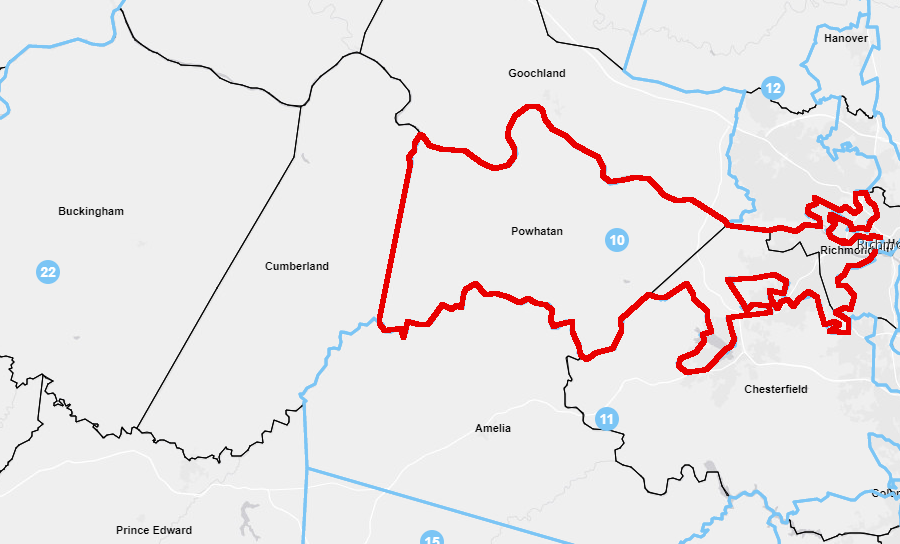
the State Senator representing Powhatan County (Senate District 10) failed to get the General Assembly to block the mega-landfill in Cumberland County (Senate District 22)
Source: Cumberland County, Virginia Redistricting Commission
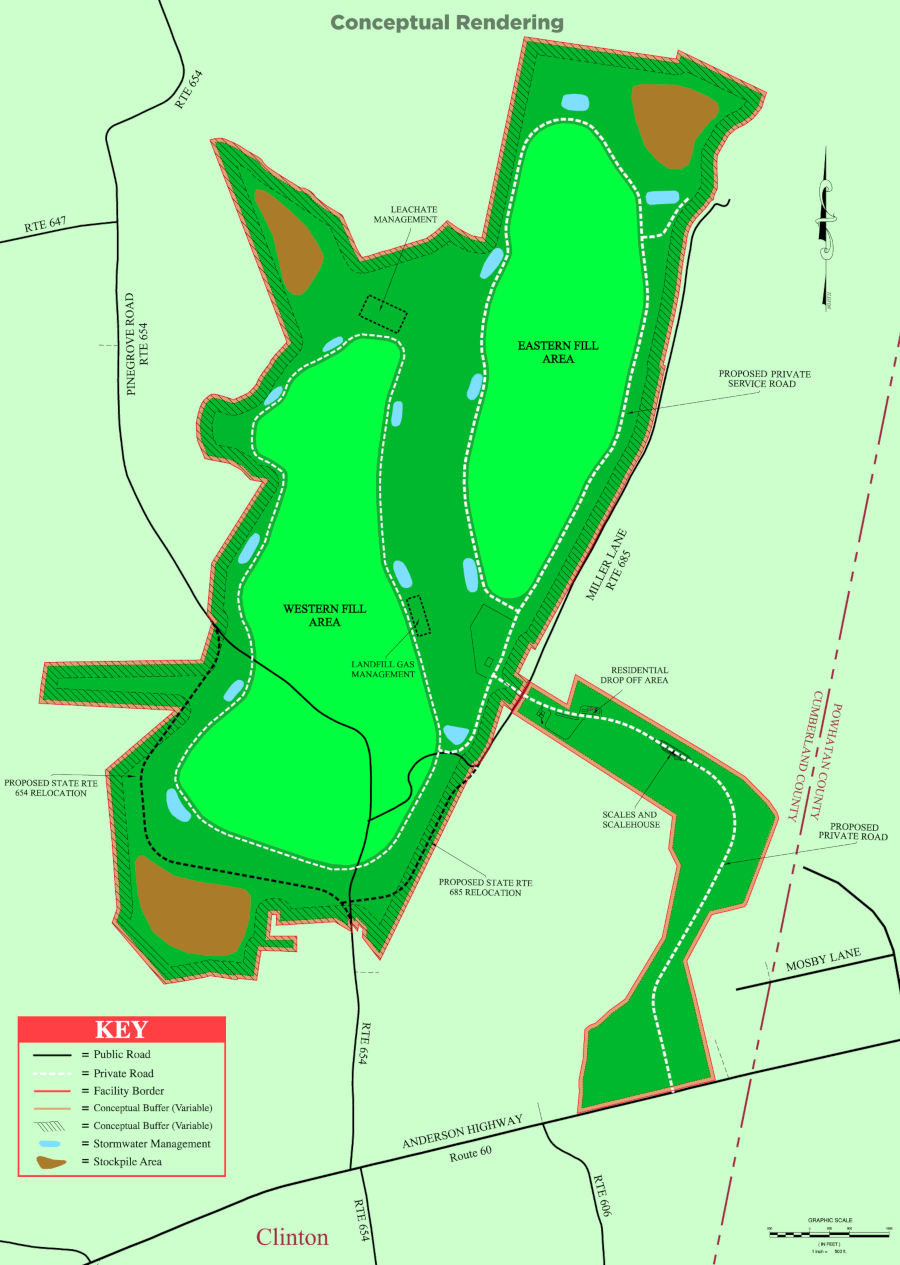
Cumberland County officials approved the Green Ridge mega-landfill despite objections by Powhatan County residents
Source: Green Ridge Recycling and Disposal Facility, Project Description